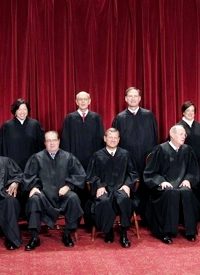
An article in the Washington Post today relates how Supreme Court justices are spending the early days of the latest session parsing the language of various statutes to determine the merits of the constitutional questions arising from them. One day, says Robert Barnes, author of the piece, the definition of “file” is debated; the next day it’s “unavoidable” that must be defined in constitutional context. Later in the week, the justices pepper counsel with questions over the interplay between verb and adverb in the phrase “necessarily implies.” On that point, Chief Justice John G. Roberts laments, “…the adverb points one way and the verb points another.”
In the article Barnes writes: “Supreme Court justices receive the most attention when they divine the Constitution to determine how it protects personal privacy or restricts the government from infringing on gun rights.” Those are certainly provocative issues, and any court addressing them will be the beneficiary (welcome or not) of some parsing of their language by advocates on both sides, anxious to praise or pillory the bench.
Regardless of the case at bar, constitutionally speaking, what are the enumerated powers granted the Supreme Court? Article III of the United States Constitution reads in relevant part:
Section 1
The judicial Power of the United States, shall be vested in one supreme Court, and in such inferior Courts as the Congress may from time to time ordain and establish. The Judges, both of the supreme and inferior Courts, shall hold their Offices during good Behavior, and shall, at stated Times, receive for their Services a Compensation which shall not be diminished during their Continuance in Office.
Section 2
The judicial Power shall extend to all Cases, in Law and Equity, arising under this Constitution, the Laws of the United States, and Treaties made, or which shall be made, under their Authority; to all Cases affecting Ambassadors, other public Ministers and Consuls; to all Cases of admiralty and maritime Jurisdiction; to Controversies to which the United States shall be a Party; to Controversies between two or more States; between a State and Citizens of another State; between Citizens of different States; between Citizens of the same State claiming Lands under Grants of different States, and between a State, or the Citizens thereof, and foreign States, Citizens or Subjects.
In all Cases affecting Ambassadors, other public Ministers and Consuls, and those in which a State shall be Party, the supreme Court shall have original Jurisdiction. In all the other Cases before mentioned, the supreme Court shall have appellate Jurisdiction, both as to Law and Fact, with such Exceptions, and under such Regulations as the Congress shall make.
As a reading of the plain language of the text reveals, the Supreme Court has very few enumerated powers. In fact, the Court was endowed with so little weight as to be described by Alexander Hamilton as “the weakest of the three departments of power.”
Why would Hamilton, whose specialty when writing under the Publius pseudonym seemed to be the judiciary, describe the federal courts in this manner? Hamilton himself provides the answer in Federalist No. 78:
Whoever attentively considers the different departments of power must perceive that, in a government in which they are separated from each other, the judiciary, from the nature of its functions, will always be the least dangerous to the political rights of the constitution; because it will be least in capacity to annoy or injure them.
And further on in the letter defending the new government:
This simple view of the matter suggests several important consequences. It proves incontestably that the judiciary is beyond comparison the weakest of the three departments of power; that it can never attack with success either of the other two; and that all possible care is requisite to enable it to defend itself against their attacks. It equally proves that, though individual oppression may now and then proceed from the courts of justice, the general liberty of the people can never be endangered from that quarter; I mean, so long as the judiciary remains truly distinct from both the legislature and the executive.
The behavior of the modern court would astound Hamilton and would likely inspire him to reevaluate the strength of the court. Or would it? Perhaps a close examination of the rulings of the court would prove Hamilton prophetic in his estimation of judicial strength and its potential for “attacking with success” the freedom of the people and the delicate balance of separated and distinct powers as set forth in the Constitution.
For example, at the dawn of the Progressive Era, the Court destroyed the foundational doctrine of enumerated powers. Then, about a year later, it split the Bill of Rights into two separate and unequal parts: those rights that it deemed fundamental and those that are not so protected. In the first case, the Court created from whole cloth a new General Welfare clause with not a single thread from the one woven by the Founders remaining in the new garment. In the next case, the Court converted the Commerce Clause from shield against governmental overreaching into a powerful weapon of legislative tyranny. There is no basis in natural or constitutional law for this judicial gerrymandering.
Again from the Washington Post piece: “But their [the Supreme Court’s] work more often is deciphering the muddy language of legislative compromise or even the ambiguous words of their predecessors on the bench.”
The more familiar way of describing this deciphering is “judicial review.” It has been a two century-long vexation that this responsibility or power is not specifically mentioned in the Constitution. There is little debate, however, that some form of it was anticipated and accepted as settled by the Founders. At least eight of the delegates to the Constitutional Convention of 1787 asserted in the record of the debates that the Supreme Court was to enjoy such an endowment. Tellingly, there is no mention of arguments to the contrary made by other delegates. As the imminent historian Forrest McDonald wrote:
Indeed, Madison and Wilson, in contending for a council of revision, wanted to give the judges even greater power, that of vetoing legislation on policy grounds as well as on constitutional grounds. They were supported by the Connecticut, Maryland, and Virginia delegations; those of Pennsylvania and Georgia were divided.
The attention of committed constitutionalists must now turn to the Supreme Court. As with the other two branches of our government, the judiciary must be restrained within the constitutional boundaries drawn around its power. There are forces at work, both on the bench and in its shadow, determined to break the mold of federalism and separated powers cast by our Founders and replace it with a dynamic and democratic judicial panel.
If selective popular interest persists, then the Court will continue along its current trajectory of usurping legislative prerogatives and then move on to subsuming those of the executive branch, as well.
Photo: The justices of the U.S. Supreme Court gather for a group portrait at the Supreme Court Building in Washington, Oct. 8, 2010: AP Images



